How many MP do you want left after cropping?
May 15, 2012 13:09:58 #
When I Photograph birds, I always strive to fill the frame but that is rarely possible. I will crop as much as necessary to get a decent photo. If that cropping degrades the resolution too much...into the trash can it goes. (Unless it's a rarity that I am documenting.) I usually pass on taking photos of birds that are too far away. How far is that? It depends on the size of the bird and the lighting. 20 feet for a sparrow. 50-100 feet for a Great Blue Heron. So, to answer your question, for me, yes it is typical to crop a lot.
Luckily, with the Canon 7D's 18 mp sensor, I can crop down to about 25% of the image and still get a decent print out of it as long as it was sharp to start with.
I've attached some examples of what is possible. The first Red-tailed Hawk was shot with my Canon 500mm f/4 L with a 1.4 TC at 1/2000, f/9, ISO 800, from the car window. The Black Scotters with the 500mm, 1/2000, f/8, ISO 800, Tripod mounted. The last Juvenile Red-tailed Hawk was shot with the 500mm at 1/2000, f/5.6, ISO 1000, Handheld from about 25 feet away.
Luckily, with the Canon 7D's 18 mp sensor, I can crop down to about 25% of the image and still get a decent print out of it as long as it was sharp to start with.
I've attached some examples of what is possible. The first Red-tailed Hawk was shot with my Canon 500mm f/4 L with a 1.4 TC at 1/2000, f/9, ISO 800, from the car window. The Black Scotters with the 500mm, 1/2000, f/8, ISO 800, Tripod mounted. The last Juvenile Red-tailed Hawk was shot with the 500mm at 1/2000, f/5.6, ISO 1000, Handheld from about 25 feet away.
Uncropped image
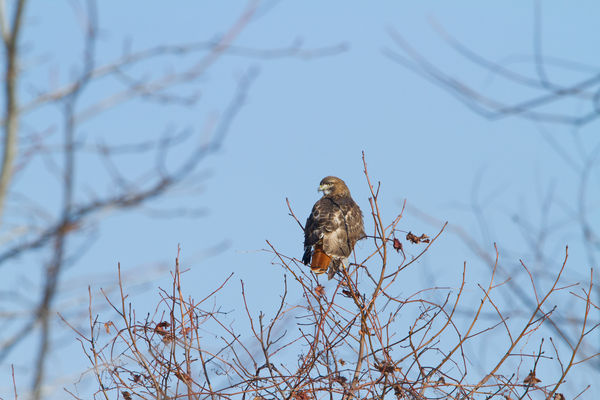
Cropped
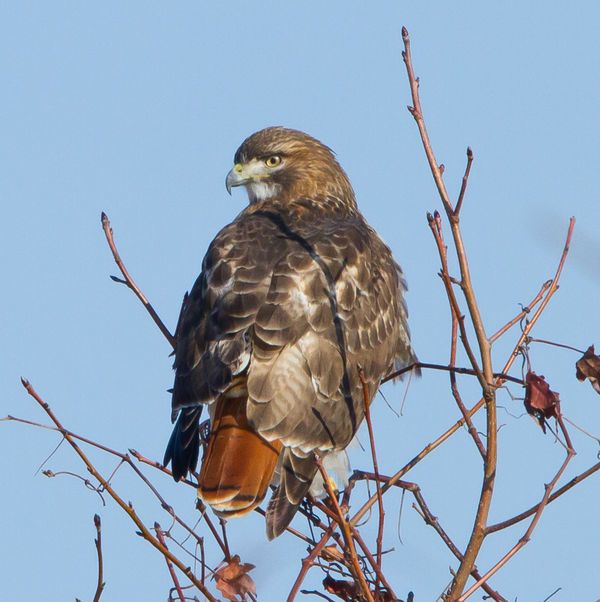
Uncropped
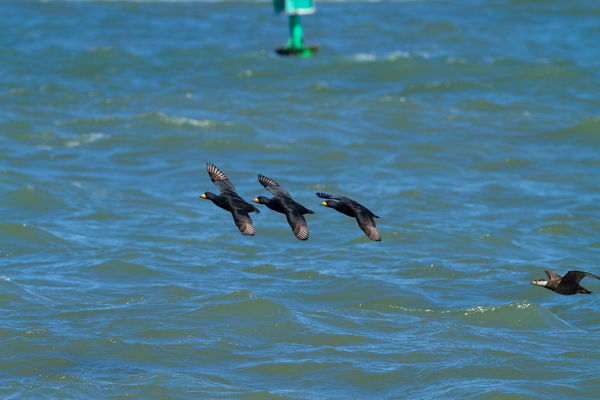
Cropped
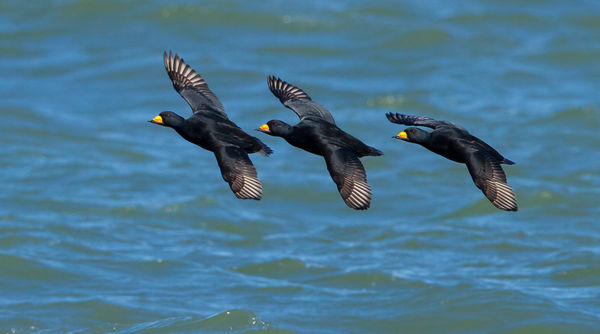
Uncropped, Full frame.
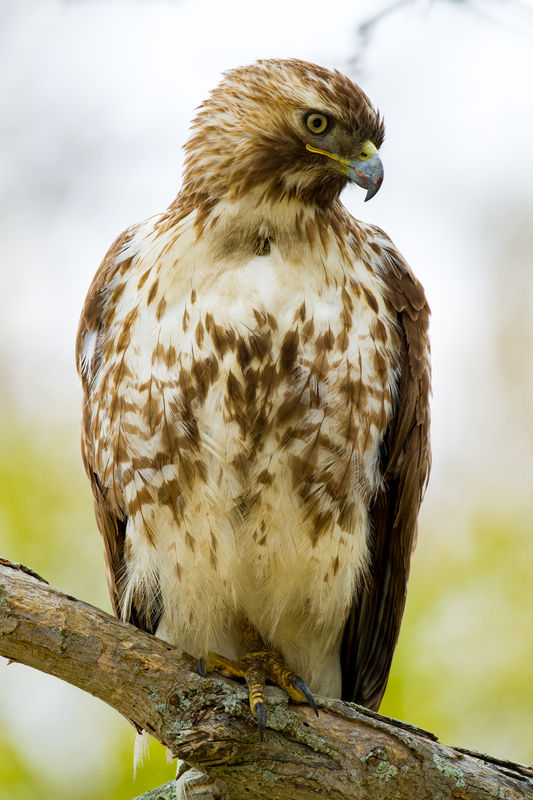
May 15, 2012 18:48:55 #
May 15, 2012 19:28:48 #
rpavich wrote:
Not getting close enough and not filling the frame are bad practices...HUGE crops lose quality.
Try filling the frame and then your crops will just be minor.
Try filling the frame and then your crops will just be minor.
Sage advice...
May 16, 2012 07:02:33 #
When you are ready to print you might want to change your thinking to PPI (pixels per inch), or DPI (Dots per inch) When I crop with Elements the new PPI is shown. I like to see as much as 300 PPI, but have found that images as low as 225 PPI look just fine. If I crop to a 8x10 print and the PPI falls to less than 225 PPI I try a 5x7 crop, or even a 4x6. Also, most printing sites will notify you if the resolution is not adequate for the print size selected. If this happens I will try for a smaller print.
May 16, 2012 07:09:31 #
As I have brought up before people need to realize, especially those new to photography, that the crop factor of DX cameras is not the same as getting close with a full frame camera.. In other words, using a DX 200 is not the same as using a full frame 300.
May 16, 2012 07:19:41 #
I'm only a beginner, but if you can't get close enough to the birds to fill the frame maybe you could try using a 1.4 or 2 x converter.
May 16, 2012 07:23:55 #
I'm only a beginner but if you can't get close enough to fill the frame maybe you could use a 1.4 or 2 x converter.
May 16, 2012 07:24:40 #
I'm only a beginner but if you can't get close enough to fill the frame maybe you could use a 1.4 or 2 x converter.
May 16, 2012 08:17:32 #
What happens frequently is that a raw file is downloaded to a program to do post production work. Many if not most post production programs will convert the image to jpeg. This will reduce the mpx by about half. Then when you crop you will be down to about 1/4 to 1/3 of the original mpx. Somewhere around 1.7 to 2.5 (based on a 12 mpx camera). Some of the better programs will allow you to do post production work on a raw image. If you do that and then crop you will still end up with a 5 to 7 mpx. file. I have seen beautiful 16 x 20 prints taken with a D70 which was only a 6.1 mpx camera. I also made a 30 x 40 print from an 8 mpx camera a few years ago. Everyone should remember that until about four years ago the top mpx on most pro cameras was around 12 mpx. It may be nice to have 24/36 mpx, but not necessary to get wonderful enlargements. Also there are programs that can "fill in" pixels to allow smaller files to produce much larger shots. They usually are advertised as some type of fractal programs.
May 16, 2012 08:23:20 #
swallowtail wrote:
I'm only a beginner but if you can't get close enough to fill the frame maybe you could use a 1.4 or 2 x converter.
First time I ever saw a TRIPLE accidental post.
May 16, 2012 08:24:41 #
rpavich wrote:
Not getting close enough and not filling the frame are bad practices...HUGE crops lose quality.
Try filling the frame and then your crops will just be minor.
Try filling the frame and then your crops will just be minor.
I agree, filling the frame helps a lot but as birdpix points out when shooting wildlife it often is not possible.
You need to keep in mind you are removing part of the photo when you crop so file size will get smaller. The important things to remember when cropping is the size you are cropping to and the resolution. The higher the resolution the larger the file size and the better quality crop you will get.
Jim D
May 16, 2012 08:26:49 #
I shoot in .jpeg, but when I import in LR4, I import as a .tiff. This gives me a larger image, in inches, than if I imported as a .jpeg.
I could be wrong. I have been know to be in the past.
I could be wrong. I have been know to be in the past.
May 16, 2012 09:58:00 #
Indi wrote:
I shoot in .jpeg, but when I import in LR4, I import as a .tiff. This gives me a larger image, in inches, than if I imported as a .jpeg.
I could be wrong. I have been know to be in the past.
I could be wrong. I have been know to be in the past.
I don't see how that can possibly be true. Yes, tiff files are larger, sometimes three to four times larger. That is partly because it records more information per pixel. Most of this info is a "null" value and doesn't add anything to the resolution or physical size of the picture. The pixel dimensions of a file only relate to picture size in inches upon output such as by print or screen.
I don't even understand why wou would import your JPG's as TIFF to start with. LR is a non destructive editor and allows you to export as TIFF if you needed to. The only thing I think you are accomplishing is taking up 3-4 times the hard drive space.
I may be wrong, too. If someone has more knowledge, chime in!
May 16, 2012 10:07:43 #
Sorry about that, I'm new to all this. No Idea what happened!!!
May 16, 2012 10:14:38 #
birdpix wrote:
quote=Indi I shoot in .jpeg, but when I import in... (show quote)
I hope you're right. I can stop importing the larger files, and save a lot of space. I already have 4 external HDs.
If you want to reply, then register here. Registration is free and your account is created instantly, so you can post right away.








